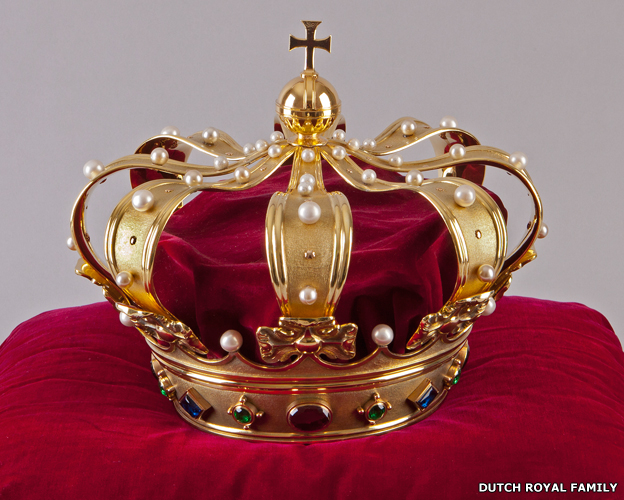King Willem-Alexander: Dutch crown explained
- Published
Used for ceremony rather than being worn, the crown stands 23.5cm high and is 31cm in diameter at its widest point. It consists of eight arches topped with an orb and cross.
The crown was created in 1840 for King Willem II, by Bonebakker Jewellers of Amsterdam. It is fashioned from silver plated with gold.
There were originally 72 fake pearls on the arches of the crown, but 24 were removed in 1898 and the holes filled with small gold studs.
A red silk velvet lining covers the inside of the crown.
There are no precious stones in the crown, the gems are made from coloured glass backed by foil.
The crown is not worn - and monarchs of the Netherlands are inaugurated rather than crowned - but it is placed on a cushion on a table while the ceremony takes place.
The Dutch royal family has a crown, but there is no coronation and the monarch does not wear it.
As Willem-Alexander was sworn in as king of the Netherlands on Tuesday, the crown sat on a table next to him, along with the other regalia that make up the crown jewels.
The tradition of not crowning the monarch dates from 1815, when Willem I became the monarch of the newly created Kingdom of the Netherlands, says Han van Bree, a historian who specialises in the Dutch royal family.
That kingdom included modern-day Belgium, and while the Belgians were Catholics, the Dutch were Protestants, raising the "problem of who would put the crown on the king's head", explains Mr van Bree.
Leaving the crown to one side also helped dodge the question of whether the king's sovereignty came from the people, or from God.
Neither the Kingdom of Belgium, once it became independent, nor the Scandinavian monarchies that took their modern form in a similar era, chose to have coronation ceremonies.
"It has to do with the fact that these are relatively modern kingdoms," says Mr Van Bree. "All these monarchies are 19th Century inventions."
In the Netherlands, there was resistance to the kind of grand regal displays adopted by older monarchies.
In 1816, a Dutch crown was nonetheless designed to replace the old one, initially for symbolic use such as on letterheads.
It was manufactured by the Amsterdam jeweller A Bonebakker & Son in time for the accession of Willem II in 1840, at a cost 1,470 Dutch guilders.
This is the crown that survives, and according to the Dutch monarchy's website, external, it represents "the sovereignty of the Kingdom of the Netherlands and the dignity of the head of state".
It is made of gold-plated silver, but the jewels were fakes, with the stones around the bottom rim made from coloured glass and a foil backing.
The arches originally held 72 fake pearls, though 24 of these were removed in 1898 and replaced with studs.
Even if Willem-Alexander wanted to wear it, there might be a problem because it was made for an unusually large head, says Dutch journalist Perro de Jong.
The crown is 23.5cm (9.2in) high and, at the widest part, 31cm (12.2in) in diameter.
